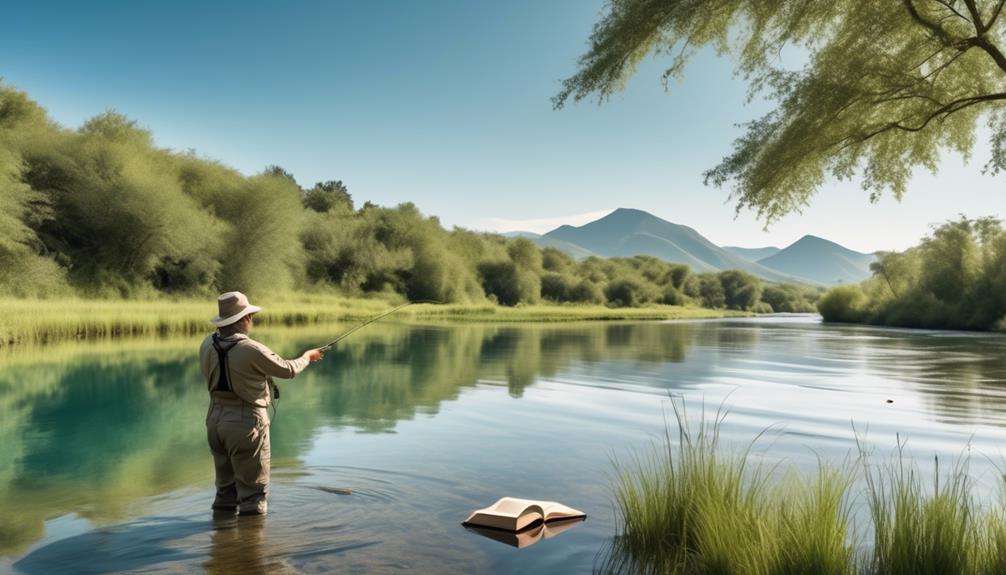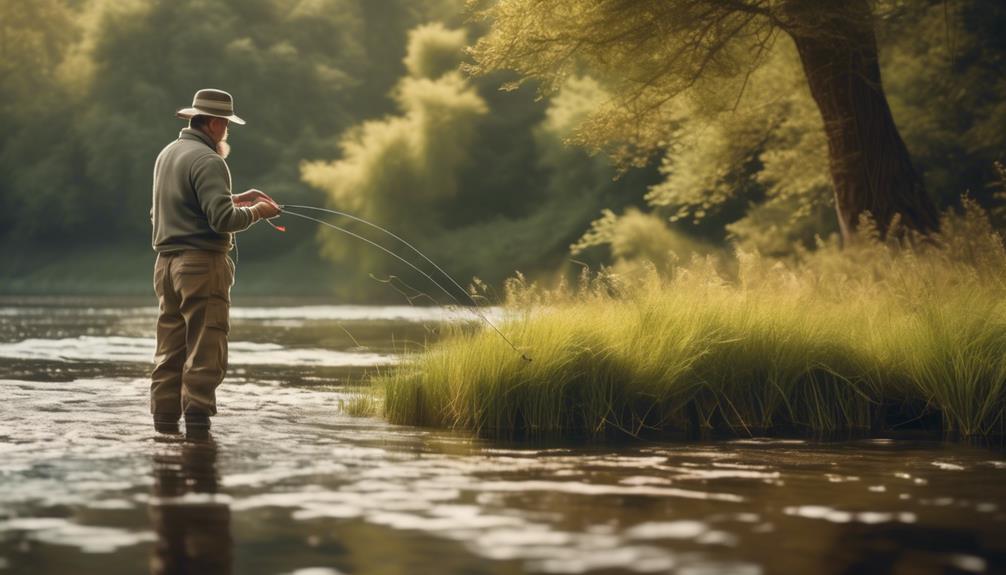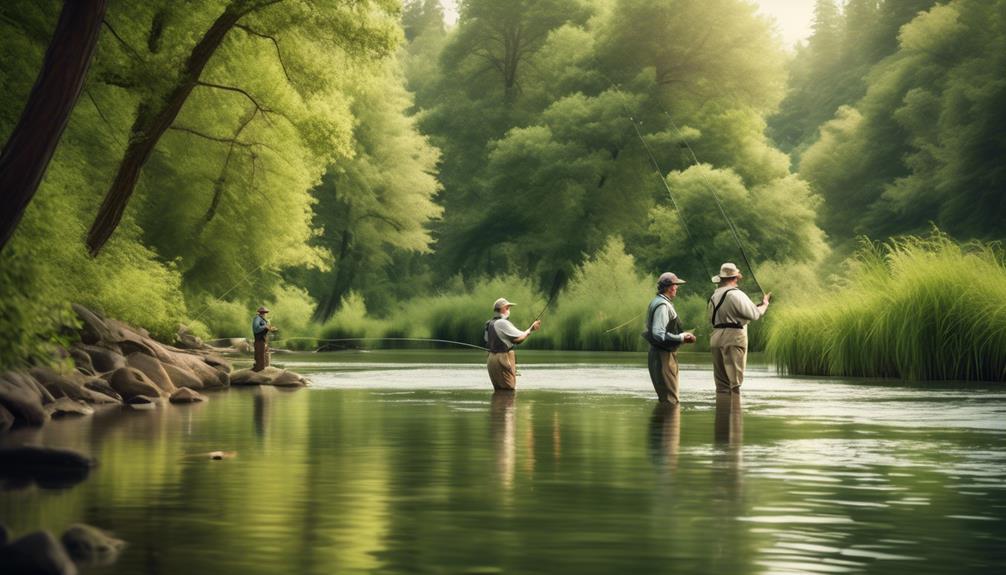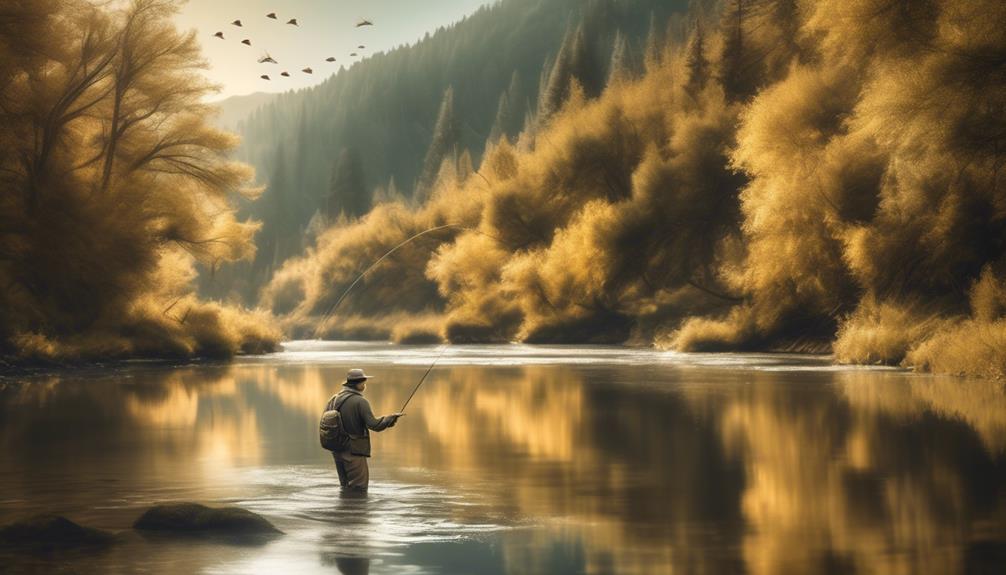Are you tired of sifting through countless fly fishing books, each promising to be the ultimate guide for beginners? Look no further. These introductory fly fishing books offer a comprehensive and structured approach to mastering the art of fly fishing.
But what sets them apart from the rest? Well, the answer lies in the unique combination of expert insights, practical tips, and step-by-step instructions that are tailored to help you swiftly progress from a novice to a proficient angler.
So, what exactly makes these books the go-to choice for anyone looking to dive into the world of fly fishing?
The Basics of Fly Fishing
If you're new to fly fishing, understanding the basics is essential for success on the water. Fly fishing techniques and equipment play a crucial role in your angling experience.
When it comes to techniques, mastering the art of casting is fundamental. Whether it's the overhead cast, roll cast, or the sidearm cast, each has its own advantages in different fishing scenarios. Understanding when and how to use these techniques can greatly improve your chances of a successful catch. Additionally, learning how to mend the line and properly present the fly to the fish is equally important.
As for equipment, having the right gear can make all the difference. A good fly rod, reel, and line are essential. The weight and length of the rod, the type of reel, and the weight-forward or double-taper line all contribute to the overall performance of your setup. Understanding the purpose of different flies and when to use them is also crucial. From dry flies to nymphs and streamers, each serves a specific function, and knowing which one to use in different conditions can significantly impact your success.
Understanding Fly Fishing Gear
Understanding the different types of fly fishing gear and their specific functions is essential for enhancing your angling experience. When it comes to understanding equipment, there are several key pieces of gear to consider. Here's a breakdown to help you grasp the essentials:
- Rods and Reels
Different rod lengths and actions are suited for various fishing conditions and casting techniques. Match your rod with an appropriate reel that balances well and has a smooth drag system for effective line control.
- Lines and Leaders
Selecting the right fly line weight and design is crucial for casting accuracy and presentation. Leaders are tapered to provide a smooth transition from the thick fly line to the nearly invisible tippet, allowing for delicate fly placement and natural drifts.
Understanding gear selection is equally important, as it can greatly impact your overall fishing experience. By choosing the right gear, you can optimize your performance and increase your chances of success on the water. Learning about the different gear options available and their specific functions won't only improve your understanding of the sport but also enhance your ability to adapt to different fishing scenarios.
As you continue to explore the world of fly fishing, having a solid understanding of gear will empower you to make informed decisions and ultimately elevate your angling skills.
Essential Fly Casting Techniques
To master essential fly casting techniques, practice precision and control in your movements. Proper wrist movement and timing are crucial for successful fly casting. Begin by holding the fly rod with a relaxed grip and using your wrist to control the movement. Avoid excessive force and focus on smooth, fluid motions. As you cast, the timing of your movements is essential. The acceleration and sudden stop of the rod should be synchronized with the unfurling of the line to achieve the desired distance and accuracy.
Line control is another key component of fly casting. As you cast, focus on maintaining a straight-line path to ensure the fly line travels in the intended direction. Proper application of power and energy through the rod will help you achieve the desired line control.
Keep in mind that accuracy is paramount in fly casting. Practice casting to specific targets, such as a floating object on the water, to improve your accuracy. By consistently aiming for precise targets, you'll refine your casting technique and improve your overall accuracy.
Identifying Fly Fishing Knots
Mastering essential fly casting techniques requires understanding and utilizing various fly fishing knots to secure your fly, leader, and tippet effectively. When it comes to identifying fly fishing knots, it's essential to grasp the basics of knot tying and dedicate time to practice. Here's what you need to know:
- Knot Tying and Practice
- Start with the basics: Begin by learning fundamental knots such as the improved clinch knot, the surgeon's knot, and the blood knot. These knots are the building blocks for more advanced connections in fly fishing.
- Practice makes perfect: Like any skill, proficiency in tying fly fishing knots comes with practice. Set aside time to practice knot tying, especially those that are commonly used in fly fishing, to ensure that you can tie them quickly and securely when you're out on the water.
- Knot Variations and Importance
- Understand knot variations: There are various variations of each knot, and understanding when and how to use these variations can make a significant difference in the strength and efficiency of your knots.
- Importance of proper knots: Properly tied knots are crucial for the success of your fly fishing endeavors. They're the connection between you and the fish, and a poorly tied knot can result in lost fish and lost opportunities.
Learning and mastering fly fishing knots is an integral part of becoming a proficient angler. So, take the time to understand the various knots, practice tying them, and recognize the importance of using the right knot for the right situation.
Selecting the Right Flies
Choosing the right flies for your fly fishing endeavors can significantly impact your success on the water. Selecting fly patterns that match the hatch is crucial for enticing fish to bite. When it comes to matching the hatch, observe the insects in the area to determine their size, color, and behavior. This will help you choose the appropriate flies that closely resemble the natural food source of the fish.
Different fly patterns imitate various stages of insect life, such as nymphs, emergers, duns, and spinners. It's essential to have a selection of flies that cover these different stages, as fish often key in on specific phases of insect activity. Additionally, consider the water conditions and the type of fish you're targeting. For example, if you're fishing in clear, slow-moving water for selective trout, using realistic imitations may be necessary. On the other hand, in murky or fast-flowing water, more impressionistic patterns may suffice.
It's also important to experiment with different flies if you're not having success. Sometimes, a simple change in fly pattern can make all the difference. Pay attention to how the fish are responding and be prepared to switch things up if needed.
Navigating Fly Fishing Waters
When navigating fly fishing waters, understanding the layout and flow of the river or stream is essential for targeting productive fishing spots. To make the most of your fly fishing experience, consider the following tips:
- Reading the Water:
- Look for riffles, where the water is broken by rocks, as these are often feeding areas for fish.
- Identify pools, which are deeper and slower-moving areas where fish tend to rest.
- Adapting Techniques to the Water:
- In riffles, try using dry flies or nymphs to imitate insects being carried by the current.
- For pools, consider using streamers that imitate larger baitfish to entice fish in deeper waters.
When it comes to fly fishing techniques, understanding how to adapt your approach to different water conditions is crucial. The way you present your fly can significantly impact your success. Additionally, being able to identify different fly fishing locations within a body of water is essential. By recognizing the distinct characteristics of various areas, you can effectively target different species of fish and improve your overall fishing experience.
Mastering Fly Fishing Strategies

To become proficient in fly fishing strategies, it's important to understand the behavior and feeding patterns of the target fish species. This knowledge will help you choose the right fly fishing equipment and techniques to effectively catch your desired fish.
When it comes to fly fishing equipment, having a variety of flies that mimic the insects and other prey of the fish species you're targeting is essential. Understanding the specific fly patterns that match the natural food sources of the fish will greatly increase your chances of a successful catch.
In addition to the right equipment, mastering fly fishing strategies also involves understanding and implementing various fly fishing techniques. Different fishing situations may call for different casting and retrieval techniques, such as the roll cast, reach cast, or mend. Learning and practicing these techniques will enhance your ability to present the fly naturally and entice the fish to strike.
Additionally, mastering the art of reading the water, including understanding currents, eddies, and the behavior of fish in different types of water, is crucial for successful fly fishing.
Furthermore, understanding the behavior and feeding patterns of the target fish species will allow you to anticipate where and when the fish are most likely to be feeding, enabling you to position yourself for the best chance of a successful catch.
Exploring Advanced Fly Fishing Skills
Understanding the behavior and feeding patterns of the target fish species will set the stage for honing your advanced fly fishing skills. To truly excel in the sport, consider the following advanced techniques and strategies:
- Mastering Advanced Casting Techniques
- Perfect the art of double hauling to achieve longer and more accurate casts. This technique will allow you to cast in windy conditions and cover more water efficiently.
- Learn the various types of casts, including the reach cast, tuck cast, and curve cast, to adapt to different fishing scenarios and improve presentation.
- Refining Fly Selection and Presentation
- Delve into the intricacies of matching the hatch and learn to tie more complex fly patterns to mimic specific insects and baitfish.
- Understand the importance of drag-free drifts and learn advanced mending techniques to achieve a natural presentation and entice selective fish.
To truly elevate your fly fishing skills, seek professional guidance and expert tips. Consider investing in advanced casting lessons to refine your technique and maximize your casting efficiency. Additionally, reaching out to seasoned anglers or hiring a guide for a day on the water can provide invaluable insights into advanced strategies and tactics.
With dedication and the right resources, you can take your fly fishing prowess to the next level, consistently landing elusive fish and mastering the art of fly fishing.
Frequently Asked Questions
Are There Any Specific Fly Fishing Books That Focus on Conservation and Sustainability Practices in Fly Fishing?
Looking for specific fly fishing books that focus on conservation and sustainability practices? Check out titles that cover conservation practices and sustainable fly fishing, while also providing insights on fly tying techniques and creating your own flies.
Do Any of These Introductory Fly Fishing Books Include Information on Fly Tying and Creating Your Own Flies?
Yes, these introductory fly fishing books include information on fly tying and creating your own flies. They also cover conservation and sustainability practices, making them a great choice for young beginners interested in fly fishing.
Are There Any Recommended Introductory Fly Fishing Books That Cater Specifically to Children or Young Beginners?
For young anglers and beginners, there are children's books that make great introductory fly fishing guides. They cover sustainability practices, fly tying, cultural significance, etiquette, and conservation practices, offering an engaging and educational experience.
Do Any of These Books Discuss the History and Cultural Significance of Fly Fishing in Different Regions?
Yes, some of these books delve into the history and tradition of fly fishing in different regions, shedding light on its cultural significance. They also touch on the environmental impact and practices associated with this timeless sport.
Are There Any Introductory Fly Fishing Books That Offer Guidance on Fly Fishing Etiquette and Ethics?
When choosing introductory fly fishing books, look for ones that cover fly fishing etiquette and ethical practices. These books should also delve into environmental conservation and sustainability practices for a well-rounded understanding of the sport.
Conclusion
So, if you're looking to get into fly fishing, these introductory books are a great place to start. They cover everything from the basics of fly fishing to advanced skills, providing a comprehensive guide to help you become a successful angler.
With clear explanations and helpful tips, these books will give you the knowledge and confidence you need to enjoy the art of fly fishing.
Happy fishing!



